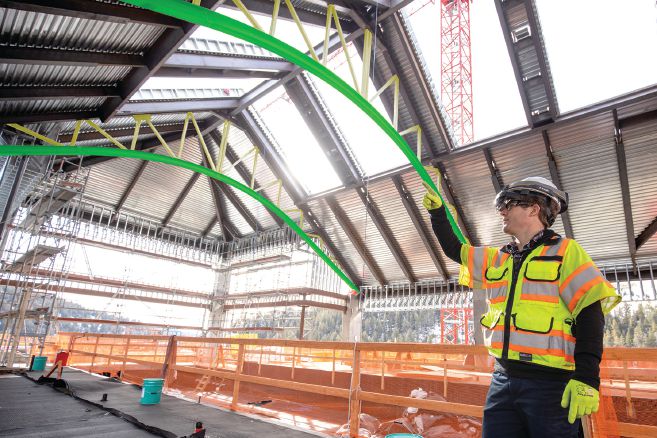Infrastructure Outlook: Putting Designs into Motion with Extended Reality

The digitization of data is paving the way for more-advanced technology that connects the design process to real-world information. The key to digitization is tying in 3D models at the start of the design process and integrating constructible data that enable all stakeholders to work together and share data in real-time to optimize the design, build and operate lifecycle.
When it comes to planning and design, how do you tie data in the model from the office to the field? Augmented- and mixed-reality devices in the field connected to software in the office can facilitate this process.
Augmented- and mixed-reality technology can be used to create holographic versions of models that are precisely aligned with real-world environments, allowing engineers to study and analyze how their coordinated models will be implemented in the context of the jobsite while still in the design stage.
Building the Future with Immersive Technologies

Augmented-reality (AR) technology combines the physical and virtual worlds together by overlaying digital information into the user’s environment, usually via a two-dimensional display such as a smartphone or tablet. Mixed-reality (MR) technology takes augmented reality one step further by merging the two worlds and providing the ability for the user to interact with the data as if it were physically in their environment. This is often done in 3D using a binocular head-mounted device. It’s “mixed” reality because it encompasses both virtual and real environments via immersive technology, letting users see the existing space overlaid with holographic data from a 3D model and allowing them to interact with the 3D data.
Both augmented and mixed reality can be useful throughout the construction lifecycle, from planning and design to monitoring progress and identifying issues early on in the process. AR and MR tools are being used for project coordination by aligning highly accurate holographic data on the jobsite to allow users to visualize and collaborate on models in real-time throughout the entire process. They also can be used to view the progress of construction sites or conduct inspections, with the ability to instantly share information with other stakeholders.
These technologies are having a significant impact on the civil and structural engineering industry because they help address time-consuming and expensive inefficiencies during the design, construction and operation stages. This includes shortening project schedules, reducing cost, eliminating rework, supporting additional workflows such as onsite assembly, and monitoring progress more efficiently.
Immersive Technologies Throughout the Construction Lifecycle
Let’s take a closer look at how these technologies can help companies move from planning to design to construction.
With augmented reality, users and clients can view new designs, reveal existing hidden infrastructure (e.g., underground utilities) or visualize how new landscapes may change through time, without having to interpret multiple drawings and maps. It allows for this information to be viewed at “life scale” and in the context of its surroundings. This is a crucial area where efficiency can be improved, especially compared to today’s paper- and model-based workflows.
Mixed reality allows users to visualize 3D design earlier and more effectively than ever before, and to rapidly iterate on design ideas in 3D and collaborate with others (both collocated and remote) while immersed in the design. In industries where safety is a consideration, hands-free visualization often is preferred. In addition, users can overlay designs on the real world for things such as clash detection and renovation visualization and use models as an “instruction guide” for actual production. This is significantly improving data communication and interpretation to reduce rework, increase productivity and improve overall job quality.
Advanced visualization extends the ability for users to view assigned tasks and capture data with onsite measurement tools. This reduces human error, making projects much more efficient.
Mixed Reality on Phipps Plaza Redevelopment
One of the nation’s largest integrated design-build firms, The Beck Group, used mixed reality during the redevelopment of Phipps Plaza in Atlanta. Phipps Plaza is currently being redeveloped from a mall into a mixed-use, upscale property with a 150-room Nobu Hotel and restaurant, 13-story office building, outdoor event venue and 90,000-square-foot athletic facility. The developers knew that attaching new construction to the existing mall would require precision.
The Beck Group adopted a Constructible Process that combines design, project management and engineering models into a collaborative and data-rich platform for data sharing. To help its crew visualize existing utilities and the routing of new utilities, The Beck Group used the Trimble Connect for HoloLens mixed-reality solution for project coordination so workers could review models overlaid in the context of the physical environment.
“It was incredible to walk through the site and visualize the civil drawings overlaid in the physical space,” says Tim Riefenberg, BIM manager for The Beck Group. “Our crews could see existing utilities and where new utilities would be routed at the same time to better plan for excavations and avoid costly mistakes.”
When integrated with quality construction software and using 3D BIM models as a primary data source, augmented and mixed reality improve communication, tighten workflow integration and enable real-time collaboration with remote teams.
These technologies are transforming the way civil and structural engineers consume and interact with information. Whether it’s communicating and coordinating new designs with others, doing inspections or calculating quick measurements, augmented and mixed reality make understanding the project simple at every step of the process. It’s easy to share models and other project information across teams and get them up-to-speed quickly, creating a win-win for all stakeholders.
About Jordan Lawver
Jordan Lawver is portfolio manager, Mixed Reality, at Trimble; web: www.mixedreality.trimble.com.


